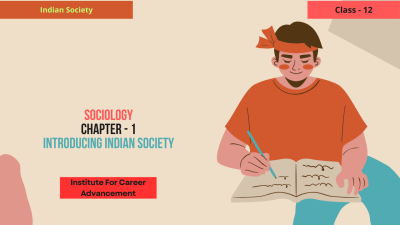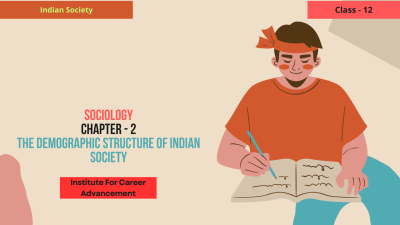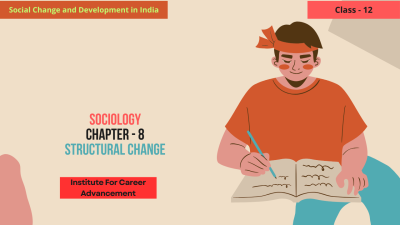Patterns of Social Inequality and Exclusion - Class 12
Patterns of Social Inequality and Exclusion is a Class 12 course that explores the various forms of social inequality and exclusion that exist within Indian society. It examines the causes, consequences, and potential solutions to these problems. Key Topics: Caste-Based Inequality: The role of caste in perpetuating social inequality and discrimination. Class-Based Inequality: The economic disparities between different social classes and their impact on opportunities and life chances. Gender-Based Inequality: The discrimination and marginalization faced by women and girls in Indian society. Regional Inequality: The disparities in development and opportunities between different regions of India. Tribal Inequality: The challenges faced by tribal communities and their marginalization in Indian society. Social Exclusion: The process of excluding individuals or groups from participating fully in society. Social Justice: The concept of fairness and equality in society, and the efforts to address social inequality and exclusion. Learning Objectives: Understand the different forms of social inequality and exclusion in India. Analyze the causes and consequences of these inequalities. Evaluate the impact of social inequality on individuals and communities. Develop critical thinking and problem-solving skills related to social justice. Explore potential solutions to address social inequality and exclusion. Patterns of Social Inequality and Exclusion is a valuable course that provides students with a comprehensive understanding of the challenges faced by marginalized groups in Indian society. It equips them with the knowledge and skills necessary to advocate for social justice and work towards a more equitable and inclusive society. প্যাটার্নস অফ সোশ্যাল ইনইকুয়ালিটি অ্যান্ড এক্সক্লুশন হল দ্বাদশ শ্রেণির একটি কোর্স যা ভারতীয় সমাজের মধ্যে বিদ্যমান বিভিন্ন ধরনের সামাজিক বৈষম্য এবং বর্জনের অন্বেষণ করে। এটি এই সমস্যাগুলির কারণ, পরিণতি এবং সম্ভাব্য সমাধানগুলি পরীক্ষা করে। মূল বিষয়ঃ বর্ণ-ভিত্তিক বৈষম্যঃ সামাজিক বৈষম্য ও বৈষম্য বজায় রাখতে বর্ণের ভূমিকা। শ্রেণী-ভিত্তিক অসমতাঃ বিভিন্ন সামাজিক শ্রেণীর মধ্যে অর্থনৈতিক বৈষম্য এবং সুযোগ ও জীবনের সুযোগের উপর তাদের প্রভাব। লিঙ্গভিত্তিক বৈষম্যঃ ভারতীয় সমাজে নারী ও মেয়েদের বৈষম্য ও প্রান্তিককরণ। আঞ্চলিক বৈষম্যঃ ভারতের বিভিন্ন অঞ্চলের মধ্যে উন্নয়ন ও সুযোগের বৈষম্য। উপজাতি বৈষম্যঃ ভারতীয় সমাজে উপজাতি সম্প্রদায়ের সম্মুখীন হওয়া চ্যালেঞ্জ এবং তাদের প্রান্তিককরণ। সামাজিক বর্জনঃ ব্যক্তি বা গোষ্ঠীকে সমাজে সম্পূর্ণরূপে অংশগ্রহণ থেকে বাদ দেওয়ার প্রক্রিয়া। সামাজিক ন্যায়বিচারঃ সমাজে ন্যায্যতা ও সমতার ধারণা এবং সামাজিক বৈষম্য ও বর্জন মোকাবেলার প্রচেষ্টা। শেখার উদ্দেশ্যঃ ভারতে সামাজিক বৈষম্য এবং বর্জনের বিভিন্ন রূপগুলি বুঝুন। এই বৈষম্যের কারণ ও পরিণতি বিশ্লেষণ করুন। ব্যক্তি ও সম্প্রদায়ের উপর সামাজিক বৈষম্যের প্রভাব মূল্যায়ন করুন। সামাজিক ন্যায়বিচার সম্পর্কিত সমালোচনামূলক চিন্তাভাবনা এবং সমস্যা সমাধানের দক্ষতা বিকাশ করুন। সামাজিক বৈষম্য এবং বর্জন মোকাবেলায় সম্ভাব্য সমাধানগুলি অন্বেষণ করুন। প্যাটার্নস অফ সোশ্যাল ইনইকুয়ালিটি অ্যান্ড এক্সক্লুশন একটি মূল্যবান কোর্স যা শিক্ষার্থীদের ভারতীয় সমাজে প্রান্তিক গোষ্ঠীগুলির সম্মুখীন হওয়া চ্যালেঞ্জগুলি সম্পর্কে ব্যাপক ধারণা প্রদান করে। এটি তাদের সামাজিক ন্যায়বিচারের পক্ষে এবং আরও ন্যায়সঙ্গত ও অন্তর্ভুক্তিমূলক সমাজের জন্য কাজ করার জন্য প্রয়োজনীয় জ্ঞান ও দক্ষতার সাথে সজ্জিত করে।
English
Last updated
Wed, 27-Nov-2024



















